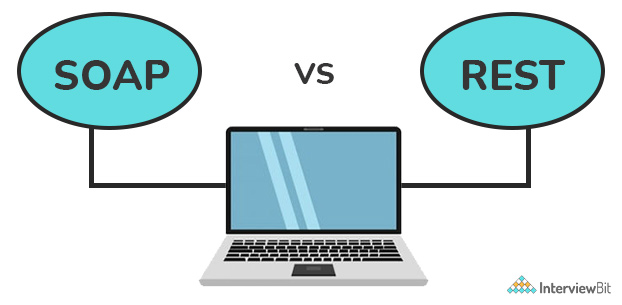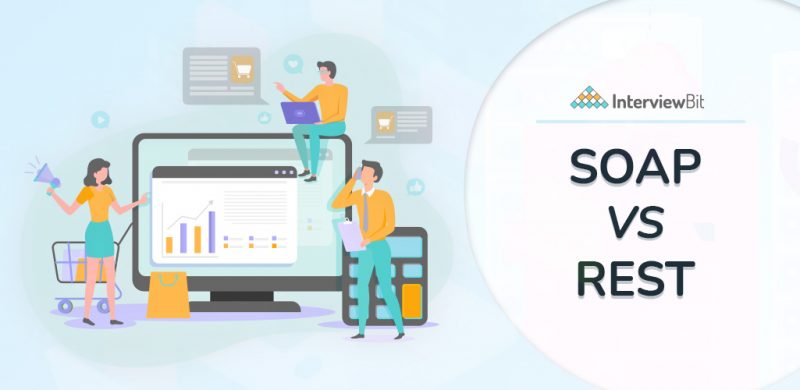Exchanging data between applications is a crucial part in today’s world. Applications are written in different languages so data exchange has become a complex process. Web Services are the standardized medium to propagate communication between client-server applications on the world wide web.
What is SOAP?
SOAP (Simple Object Access Protocol) is an XML-based protocol for accessing web services over HTTP. It is developed as an intermediate language so that applications built in various programming languages can communicate with each other effectively. Web services use SOAP for the exchange of XML data between applications. SOAP supports both stateful and stateless operations. Stateful means that the server keeps the information that it receives from the client across multiple requests. These requests are chained together so that the server is aware of the previous requests. Examples are bank transactions, flight bookings, etc. Stateless messaging has enough information about the state of the client so that the server does not have to bother.
What is REST?
REST (Representational State Transfer) is an architectural approach for communication purposes often used in various web services development. It is a stateless client-server model. Web services that are defined by the concept of REST are RESTful web services. When a client makes a request via RESTful API, it transfers the representation of the state of the resources to the server. This information can be transferred in various formats via HTTP like JSON, HTML, XLT, and Plain Text, but JSON is the most common language used due to its easy readability by machines and humans.
Confused about your next job?
Features of SOAP
- SOAP is an entirely XML-based protocol, the data formatting is in XML so it’s easy for programmers to understand it.
- It is a platform-independent protocol.
- It is an open standard protocol so anyone can use it.
- It is an extension to the HTTP protocol for XML messaging.
- SOAP messaging is useful for broadcasting messages from one computer to the other computers.
- It is also feasible to implement the client-server architecture. The client can invoke a remote procedure call located on the server side by using the SOAP protocol message.
- SOAP provides data transport for web services.
- SOAP works by sending an envelope which contains information about what is to be done with web services. A typical SOAP envelope contains a header and body with a WSDL (Web Service Definition Language) file. This whole envelope is sent to the service provider and that’s why SOAP needs larger bandwidth.
Features of REST
- These are fast web services as they consume less bandwidth and resources.
- REST can be written in any programming language.
- These services can be executed on any platform.
- It is a lightweight and scalable service built on REST architecture.
- It uses HTTP verbs like GET, POST, DELETE, PUT and PATCH for CRUD (Create, Read, Update and Delete) operations.
- It supports basic communication encryptions through TLS (Transport Layer Security), therefore less secure than SOAP.
- It is simpler to develop.
- It requires less bandwidth as compared to SOAP.
SOAP vs REST

| Parameters | SOAP | REST |
| Full form | It stands for Simple Object Access Protocol | It stands for REpresentational State Transfer. |
| Design | It is a standardized protocol for pre-defined rules to follow. | It has an architectural style with loose guidelines. |
| Statefulness | SOAP is by default stateless, but it is possible to make this API stateful. | It is stateful, i.e. no server-side sessions occur. |
| Approach | It is functional-driven, means that data here is available as services, eg, getUser | It is data-driven, meaning that data is available as resources. |
| Security | It has WS-security (Enterprise-level security) with SSL support. It also has built-in ACID(Atomicity, Consistency, Integrity, Durability) compliance which is a good feature for transactions and that’s why SOAP is used while exchanging sensitive information. | It supports HTTPS and SSL (Secure Sockets Layer) |
| Caching | SOAP API calls cannot be cached. | REST API calls can be cached. |
| Performance | It requires more bandwidth and computing power | It requires less resources, and this makes it more powerful. |
| Messaging Format | It only supports XML format. | It supports various formats like HTML, XML and JSON. |
| Transfer Protocol | It works on HTTP, SMP, UDP, etc. So it is recommended | It only works on HTTPS. |
| JAVA API | JAX-WS is the java API for SOAP web services. | JAX-RS is the java API for REST. |
| Usage with one another | SOAP cannot use REST because SOAP is a protocol and REST has an architectural style. | REST can use SOAP as a protocol for web services. |
| Exposing methods | SOAP uses WSDL to expose supported methods and technical details. | REST exposes methods through URIs, there are no technical details. |
Conclusion
We discussed the two most popular web services SOAP and REST. Both have their own importance in different scenarios. We need to choose one of them based on our requirements and the complexity of the application. REST is simpler to develop but on the other hand SOAP provides various other alternatives, therefore it is slightly difficult to develop.
FAQs
Q.1: Is REST API better than SOAP?
Both web services have their importance in different scenarios. REST is a simple, scalable and lightweight service. It makes efficient use of bandwidth because unlike SOAP it sends a postcard to the service provider. It supports many data formats. It is preferred for public APIs but for enterprise-level SOAP is preferred. REST is easy to write and understand. But as mentioned in the above explanations SOAP is much more secure than REST.
Q.2: Is SOAP more secure than REST?
Yes, SOAP is more secure than REST. It is well standardized through WS-Security and WS_AtomicTransactions. It is beneficial where there is a high need for transaction reliability.
Q.3: When should I use SOAP over REST?
SOAP is beneficial in situations where there is a need to perform a transaction that requires multiple calls to a service to complete a particular task. SOAP is ideal for enterprise-level services. One real-world usage of SOAP over REST is its use in the banking industry. In case of failed transactions, SOAP will retry the transaction ensuring that the request is completed, but in REST, failed calls are manually handled by requesting application.
Q.4: Can REST use SOAP?
Yes, REST can use SOAP because SOAP is a protocol and like other protocols, for example, HTTP, REST can utilize SOAP too.
Q.5: What are the disadvantages of REST web services?
- There can be no asynchronous call, as it only works on HTTP.
- Sessions cannot be maintained in REST.
Q.6: What is WSDL?
WSDL stands for Web Service Description Language. This XML document contains web service information like method name, method parameter. Some of its important components are: <message>, <portType>, and <bindings>.
Q.7: What do you mean by a SOAP message?
A SOAP message contains the data that is sent to the application from web services. It is an XML document used to provide data to client applications written in different languages. These are sent via HTTP.
Q.8: What are the different HTTP methods in REST?
- GET: Read-only access to the resource.
- PUT: Create new resources.
- DELETE: Remove the resource.
- POST: Update the existing resource.
- OPTIONS: Get supported operations to the resource.
- HEAD: Return HTTP header only.




